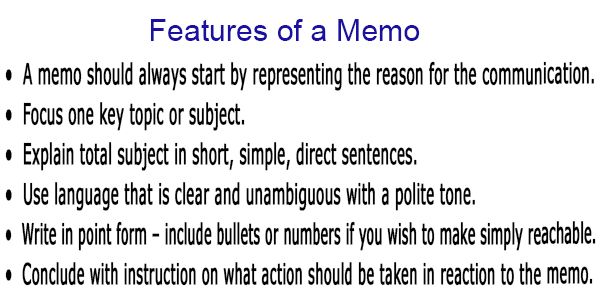A memo is a letter from one person to another or others within an organization. It can be sent on a document or by electronic mail. It often reports briefly on an action, raises a question, or asks agreement to follow a course of action.
The business memorandum, or memo, is used mainly as a formal, substantial means of competent communication from a section to the workforce; it is approximately constantly for internal communication and only hardly ever sent to clients or the public.
The key features of a successful memo are as follows:
- A memo should always start by representing the reason for the communication.
- Focus one key topic or subject.
- Explain total subject in short, simple, direct sentences.
- Use language that is clear and unambiguous with a polite tone.
- Write in point form – include bullets or numbers if you wish to make simply reachable.
- Conclude with instruction on what action should be taken in reaction to the memo.
Common Features of the memo
Office memo is a written method of internal communication. It is used to exchange information within the organization related to an organization’s day-to-day activities. As an independent method of internal communication, it possesses the following features:
- Nature
A memo is mainly written as a method of internal communication. It is used to exchange information related to internal activities of the organization between the superiors and subordinates.
- Nature of the parties involved
A memo is generally exchanged among the various internal parties of the organization. No external party can be part of the memo.
- Definite structure
A memo is prepared by following a definite structure. A title, names of the sender and receiver, date, subject, body and sender’s signature are the various parts of the memo.
- Professional and Formal Tone
Since the memo is a method of internal communication, it is less formal. However, in preparing upward moving memo a minimum degree of formality should be followed as it goes from subordinates to the superiors.
Memos are often announcements, and the person sending the memo speaks for a part or all of the organization. While it may include a request for criticism, the message itself is linear, from the association to the employees. The memo might have lawful standing as it often reflects policies or procedures, and might indicate an existing or new strategy in the worker guidebook, for example.
- Conciseness
A memo is generally written concisely. Whatever the subject matter of a Memo is, it writes directly and briefly.
- Mentioning a specific issue
An individual memo should contain only a single issue. If an individual memo contains more than one issue, they should be mentioned in a separate paragraph.
- Expression of courtesy
Though the memo expresses the message directly and concisely, it maintains courtesy and modesty in expressing the message.
- Nature of message exchanged
The information exchanged through memo is related to the internal activities of the organization. It does not carry any personal information.
- Preserving information
Since the memo is a written document, it can be preserved for future use if necessary.
- Audience Orientation
Always judge the audience and their needs when preparing a memo. An acronym or abbreviation that is known to administration might not be known by all the employees of the organization, and if the memo is to be posted and circulated within the organization, the objective is plain and summarizing communication at all levels with no uncertainty.
- Subject Emphasis
The subject is usually confirmed in the subject line and should be clear and summarizing. If the memo is announcing the execution of a holiday, for example, the particular holiday should be named in the subject line—for example, use “Thanksgiving weekend agenda” rather than “holiday observance”.
Basic Principles –
- Required and adequate information,
- Do not think that everybody knows the whole thing related to the subject discussed in the Memo
- Be understandable, tangible and precise.
- Explain with easiness and Co-operation
- No emotional or disturbing appeal.















